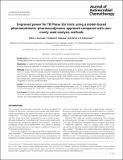Improved power for TB phase IIa trials using a model-based pharmacokinetic-pharmacodynamic approach compared with commonly used analysis methods
Abstract
Background : The demand for new anti-TB drugs is high, but development programmes are long and costly. Consequently there is a need for new strategies capable of accelerating this process. Objectives : To explore the power to find statistically significant drug effects using a model-based pharmacokinetic–pharmacodynamic approach in comparison with the methods commonly used for analysing TB Phase IIa trials. Methods : Phase IIa studies of four hypothetical anti-TB drugs (labelled A, B, C and D), each with a different mechanism of action, were simulated using the multistate TB pharmacometric (MTP) model. cfu data were simulated over 14 days for patients taking once-daily monotherapy at four different doses per drug and a reference (10 mg/kg rifampicin). The simulated data were analysed using t-test, ANOVA, mono- and bi-exponential models and a pharmacokinetic–pharmacodynamic model approach (MTP model) to establish their respective power to find a drug effect at the 5% significance level. Results : For the pharmacokinetic–pharmacodynamic model approach, t-test, ANOVA, mono-exponential model and bi-exponential model, the sample sizes needed to achieve 90% power were: 10, 30, 75, 20 and 30 (drug A); 30, 75, 245, 75 and 105 (drug B); 70, >1250, 315, >1250 and >1250 (drug C); and 30, 110, 710, 170 and 185 (drug D), respectively. Conclusions : A model-based design and analysis using a pharmacokinetic–pharmacodynamic approach can reduce the number of patients required to determine a drug effect at least 2-fold compared with current methodologies. This could significantly accelerate early-phase TB drug development.
Citation
Svensson , R J , Gillespie , S H & Simonsson , U S H 2017 , ' Improved power for TB phase IIa trials using a model-based pharmacokinetic-pharmacodynamic approach compared with commonly used analysis methods ' , Journal of Antimicrobial Chemotherapy , vol. 72 , no. 8 , pp. 2311-2319 . https://doi.org/10.1093/jac/dkx129
Publication
Journal of Antimicrobial Chemotherapy
Status
Peer reviewed
ISSN
0305-7453Type
Journal article
Description
The research leading to these results has received funding from the Swedish Research Council (grant number 521-2011-3442) in addition to the Innovative Medicines Initiative Joint Undertaking (www.imi.europe.eu) under grant agreement no. 115337, resources of which are composed of financial contribution from the European Union’s Seventh Framework Programme (FP7/2007–2013) and European Federation of Pharmaceutical Industries and Associations (EFPIA) companies’ in kind contribution.Collections
Items in the St Andrews Research Repository are protected by copyright, with all rights reserved, unless otherwise indicated.

